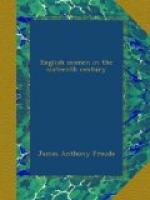In the Armada the crusading enthusiasm had reached its point and focus. England was the stake to which the Virgin, the daughter of Sion, was bound in captivity. Perseus had come at last in the person of the Duke of Medina Sidonia, and with him all that was best and brightest in the countrymen of Cervantes, to break her bonds and replace her on her throne. They had sailed into the Channel in pious hope, with the blessed banner waving over their heads.
To be the executor of the decrees of Providence is a lofty ambition, but men in a state of high emotion overlook the precautions which are not to be dispensed with even on the sublimest of errands. Don Quixote, when he set out to redress the wrongs of humanity, forgot that a change of linen might be necessary, and that he must take money with him to pay his hotel bills. Philip II., in sending the Armada to England, and confident in supernatural protection, imagined an unresisted triumphal procession. He forgot that contractors might be rascals, that water four months in the casks in a hot climate turned putrid, and that putrid water would poison his ships’ companies, though his crews were companies of angels. He forgot that the servants of the evil one might fight for their mistress after all, and that he must send adequate supplies of powder, and, worst forgetfulness of all, that a great naval expedition required a leader who understood his business. Perseus, in the shape of the Duke of Medina Sidonia, after a week of disastrous battles, found himself at the end of it in an exposed roadstead, where he ought never to have been, nine-tenths of his provisions thrown overboard as unfit for food, his ammunition exhausted by the unforeseen demands upon it, the seamen and soldiers harassed and dispirited, officers the whole week without sleep, and the enemy, who had hunted him from Plymouth to Calais, anchored within half a league of him.
Still, after all his misadventures, he had brought the fleet, if not to the North Foreland, yet within a few miles of it, and to outward appearance not materially injured. Two of the galleons had been taken; a third, the Santa Ana, had strayed; and his galleys had left him, being found too weak for the Channel sea; but the great armament had reached its destination substantially uninjured so far as English eyes could see. Hundreds of men had been killed and hundreds more wounded, and the spirit of the rest had been shaken. But the loss of life could only be conjectured on board the English fleet. The English admiral could only see that the Duke was now in touch with Parma. Parma, they knew, had an army at Dunkirk with him, which was to cross to England. He had been collecting men, barges, and transports all the winter and spring, and the backward state of Parma’s preparations could not be anticipated, still less relied upon. The Calais anchorage was unsafe; but at that season of the year, especially after a wet summer, the weather usually settled; and




